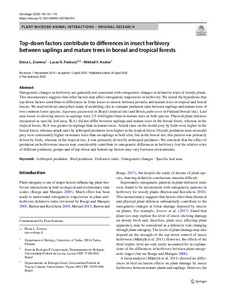Top-down factors contribute to differences in insect herbivory between saplings and mature trees in boreal and tropical forests
Paolucci Lucas N.; Kozlov Mikhail V.; Zvereva Elena L.
Top-down factors contribute to differences in insect herbivory between saplings and mature trees in boreal and tropical forests
Paolucci Lucas N.
Kozlov Mikhail V.
Zvereva Elena L.
SPRINGER
Julkaisun pysyvä osoite on:
https://urn.fi/URN:NBN:fi-fe2021042821287
https://urn.fi/URN:NBN:fi-fe2021042821287
Tiivistelmä
Ontogenetic changes in herbivory are generally not consistent with ontogenetic changes in defensive traits of woody plants. This inconsistency suggests that other factors may affect ontogenetic trajectories in herbivory. We tested the hypothesis that top-down factors contribute to differences in foliar losses to insects between juvenile and mature trees in tropical and boreal forests. We used artificial caterpillars made of modelling clay to compare predation rates between saplings and mature trees of two common forest species, Siparuna guianensis in Brazil (tropical site) and Betula pubescens in Finland (boreal site). Leaf area losses to chewing insects in saplings were 2.5-fold higher than in mature trees in both species. Physical plant defences (measured as specific leaf area, SLA) did not differ between saplings and mature trees in the boreal forest, whereas in the tropical forest, SLA was greater in saplings than in mature trees. Attack rates on the model prey by birds were higher in the boreal forest, whereas attack rates by arthropod predators were higher in the tropical forest. Overall, predation rates on model prey were consistently higher on mature trees than on saplings at both sites, but in the boreal site, this pattern was primarily driven by birds, whereas in the tropical site, it was primarily driven by arthropod predators. We conclude that the effect of predation on herbivorous insects may considerably contribute to ontogenetic differences in herbivory, but the relative roles of different predatory groups and of top-down and bottom-up factors may vary between environments.
Kokoelmat
- Rinnakkaistallenteet [19207]
